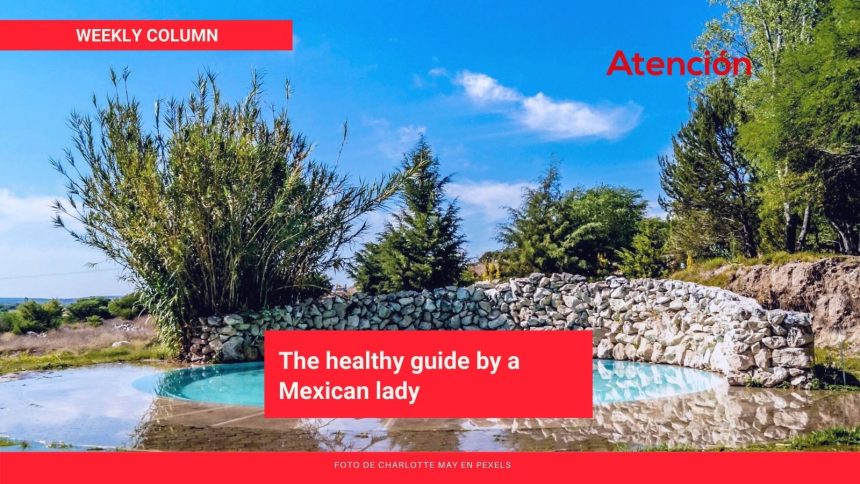By Carmen Rioja
“The deer goes to drink and appears in the water
the reflection of a tiger.
The deer drinks the water and the image. He turns
—before they devour him— (accomplice, fascinated)
equal to his enemy.“
—from “Destino” by Rosario Castellanos
The water we drink, the water we purify ourselves with, the water we heal with, is the water we will later become. This is how famous Mexican poet Rosario Castellanos understood it, revealing that we are what we drink and what we consume, imagine, dream, and fear. If we are going to experience the world, it is better to become more aware and focus our attention carefully on achieving our dreams. If we have been given the gift of free will, why not choose the best version and step away from the darkness of fear and loneliness? After all, health is but the manifestation of life in its splendor.
It is normal to meet the tiger of uncertainty that devours everything from time to time. I am one of those people to whom doubt comes before destiny. Here I am crying and wondering if the waters will return to the rivers—if friends will return and if once again, it will be safe to sunbathe on a beach or even in a garden with a hammock. Then I remember—there is life out there, beyond me and every human being.
If we continue forward, we will learn to live in a different way, hopefully, more respectful with creation and with others. And although we have not finished the battle of the pandemic, and there are still months ahead in which we must not lower our guard, it is also necessary to be proactive and work every day to improve our health. We will be better prepared for any eventuality.
But how has the pandemic affected us? One of the most serious consequences that we must face is that people stopped going to their consultations and therapies for fear of viral infections worsening their condition. Although we must take sanitary measures very seriously, let it be without stopping the indicated treatments.
If you need to rebuild your health, I recommend visiting the San Miguel de Allende hot springs during May very early in the day before the intense heat; it is low season, and it will be the best opportunity to enjoy the beautiful gardens and countryside around any of these springs. Be careful at all times and keep your distance. The regular use of a mask and washing your hands with soap, antibacterial gel, or alcohol lotion can help us prevent infections. My favorite spas are La Gruta, open from Wednesday to Sunday from 7am to 5pm and Escondido Place, open from Monday to Sunday from 8am to 5:30pm; each one has its beauty and different pools and hot springs with varying temperatures to choose from. Be careful with the number of minutes you spend in very hot water because it could lower blood pressure. It is ideal to cool off from time to time and remember to drink plenty of water to purify and rehydrate, and protect the skin with sunscreen.
In San Miguel, health tourism has its antecedents in tradition and dates back to pre-Hispanic times with the documented presence of temazcalli in pre-Hispanic ceremonial centers in the State of Guanajuato, such as Plazuelas. But it is also known for the hydrogeological conditions that resulted in a hot-spring corridor where people believe that the general state of health and well-being can be improved.
In addition, San Miguel el Grande was founded next to a spring that was called Izcuinapan, today El Chorro. Later in the 18th century, priest Luis Felipe Neri de Alfaro founded a Sanctuary for Spiritual Exercises next to the Atotonilco hot springs to offer conversion and spiritual health to the indigenous and outlaws who came to the spas to enjoy “the pleasures of the flesh” but removed from the mystical life.
To this day, the region continues to be a cultural corridor, a place of convergence between ideologies, a melting pot of coexistence. Do not miss some of these wonders of nature that creation offers us.
You can make appointments by phone and coordinate therapeutic massage or aromatherapy sessions. Also, the temazcales are by appointment so remember to organize yourself and ask your doctor everything you need to know before going.
Do not miss the exceptional wall paintings and chapels from the 18th century in the Sanctuary of Jesús Nazareno at Atotonilco, where baptism is one of the central elements along with the life of Jesus Christ. This architectural complex of more than 10 extraordinary chapels was declared a Cultural Heritage of Humanity and one of the 100 most important monuments in the world in danger of disappearing.
Carmen Rioja is a Mexican artist who specializes in art restoration and creative workshops. She likes to write stories and poems and throw them in imaginary bottles into the sea. She has published the books La Muerte Niña and Rojo 43.

